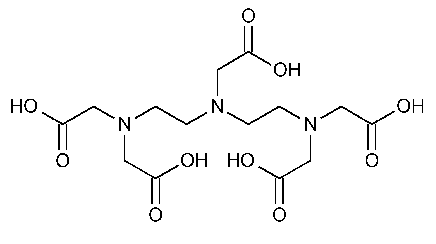Pentetic Acid
Glycine,N,N-bis[2-[bis(carboxymethyl)amino]ethyl].
Diethylenetriaminepentaacetic acid [67-43-6].
»Pentetic Acid contains not less than 98.0percent and not more than 100.5percent of C14H23N3O10.
Packaging and storage—
Preserve in well-closed containers.
Identification,Infrared Absorption á197Kñ.
Residue on ignition á281ñ:
not more than 0.2%.
Heavy metals,Method IIá231ñ:
0.005%.
Limit of nitrilotriacetic acid—
Cupric acetate solution—
Dissolve 20g of cupric acetate in a mixture of 800mLof water and 10mLof glacial acetic acid.Adjust with 1Nsodium hydroxide to a pHof 4.2,dilute with water to obtain 1000mLof solution,and filter.
Mobile phase—
Prepare a mixture of 1600mLof water,40mLof glacial acetic acid,30.4mLof 0.5Mdodecyltriethylammonium phosphate,and 20mLof Cupric acetate solution.Adjust with 1Nsodium hydroxide to a pHof 4.0,dilute with water to obtain 2000mLof solution,filter through a filter having a 0.5-µm or finer porosity,and degas.Make adjustments if necessary (see System Suitabilityunder Chromatography á621ñ).
Stock standard solution—
Transfer about 50mg of nitrilotriacetic acid,accurately weighed,to a 100-mLvolumetric flask,dilute with Cupric acetate solutionto volume,and mix.
Standard solution—
Transfer 1.0mLof the Stock standard solutionto a 25-mLvolumetric flask,dilute with Cupric acetate solutionto volume,and mix.This solution contains about 0.02mg of nitrilotriacetic acid per mL.
Test solution—
Transfer about 2g of Pentetic Acid,accurately weighed,to a 100-mLvolumetric flask.Add about 70mLof Cupric acetate solution,and swirl to dissolve.Sonicate,if necessary,to dissolve.Dilute with Cupric acetate solutionto volume,and mix.
Resolution solution—
Transfer 1.0mLof the Stock standard solutionto a 25-mLvolumetric flask,dilute with Test solutionto volume,and mix.
Chromatographic system
(see Chromatography á621ñ)—The liquid chromatograph is equipped with a 290-nm detector and a 4.6-mm ×25-cm column that contains 5-µm packing L1that has been highly deactivated (carbon loading of about 30%).The flow rate is about 1mLper minute.Equilibrate the column by passing,in sequence,water,methanol,and water for about 15minutes each,and then Mobile phasefor about 45minutes.Chromatograph the Resolution solution,and record the peak responses as directed for Procedure:the resolution,R,between pentetic acid and nitrilotriacetic acid is not less than 2.0,and the relative retention times are about 0.6for pentetic acid and 1.0for nitrilotriacetic acid.Chromatograph the Standard solution,and record the peak responses as directed for Procedure:the relative standard deviation for replicate injections is not more than 5.0%.
Procedure—
Separately inject equal volumes (about 20µL)of the Standard solutionand the Test solutioninto the chromatograph,and measure the responses for the major peaks.Calculate the percentage of nitrilotriacetic acid in the portion of Pentetic Acid taken by the formula:
10,000(C/W)(rU/rS),
of which Cis the concentration,in mg per mL,of nitrilotriacetic acid in the Standard solution,Wis the weight,in mg,of Pentetic Acid taken to prepare the Test solution,and rUand rSare the nitrilotriacetic acid peak responses obtained from the Test solutionand the Standard solution,respectively.The limit is 0.1%.
Iron—
Using 1.5g of specimen,proceed as directed in the test for Ironunder Edetic Acid.The color of the test solution is not deeper than that of the solution containing the standard iron solution (0.01%).
Assay—
Transfer about 200mg of Pentetic Acid,accurately weighed,to a 125-mLconical flask,add 50mLof water and 1.5mLof 1Nsodium hydroxide,and swirl to dissolve the specimen.Add 10mLof 0.1Nammonium thiocyanate,and mix.Add about 40mLof methyl ethyl ketone,mix,and allow the layers to separate.Titrate with 0.05Nferric ammonium sulfate VS,stirring continuously.As the titration proceeds,the aqueous phase turns from colorless to yellow,and the organic phase remains colorless.As the endpoint is approached,stop the titration,mix,and allow the layers to separate.Add 0.1-mLincrements of 0.05Nferric ammonium sulfate VS,mixing and allowing the layers to separate after each addition,until the organic layer turns from colorless to pink.Each mLof 0.05Nferric ammonium sulfate consumed is equivalent to 19.668mg of C14H23N3O10.
Auxiliary Information—
Staff Liaison:Elena Gonikberg,Ph.D.,Scientist
Expert Committee:(PA4)Pharmaceutical Analysis 4
USP28–NF23Page 1507
Phone Number:1-301-816-8251
